| |
"Jancsó's world doesn't open out into visual symbols or metaphors: it closes itself in upon a dreamy reality." |
| |
Penelope Huston, Sight and Sound, 1969 |
| |
"These works, so darkly magnificent and visually resplendent, are a gift to the world, not mere regional curiosities." |
| |
Gordon Thomas, Bright Lights Film Journal, 2008 |
If you'd asked me two or three years ago who Miklós Jancsó was, I would've given you a rather vague, literal textbook answer, derived from my years of reading on cinema as a student. There are certain names that stick the mind – Bergman, Bresson, De Sica, Fellini, Godard, Kieślowski, Kurosawa, Truffaut, Resnais, and the list goes on. The stature of these revered directors was already assured by the time I learned of their existence, fixed in film history and reduced to a series of credits that are easy to memorise, and ripe for recall should you ever need them. But, I never understood, then, the full extent of what those credits meant, and the value of them to film culture. Reading impassioned rhetoric about a film like Szegénylegények/The Round-up, or Csend és kiáltás/Silence and Cry is one thing, but seeing them for yourself, taking those iconic images in with your own eyes is entirely different. Until I had that experience for myself, Jancsó was merely a name on such a list of revered talents, hailing from a country and culture I knew little about.
My curiosity was most certainly piqued, but it would take me until this year, when I reviewed the sublime Még kér a nép/Red Psalm, to finally expand my viewing experience, and take in Jancsó's work for the first time. It was a revelation. Film culture, evolutionary by nature, means that we miss things, purely because of the point at which we arrive on it's continuum. By the time I began to engage with film in a way that extended beyond mere enjoyment – roughly in the mid 1990s – Jancsó was already well established, and making his meditative documentary series on Jewish culture, A kövek üzenete /Message of Stones. He had long since learned his trade, and was a long way from his roots in Vác, and the years he spent at Budapest's Academy of Dramatic and Film Art, where he was under the tutelage of famous film critic and screenwriter Béla Balázs, founder of the Béla Balázs studio. After graduation, he zigzagged across Hungary making short films and newsreels (propagandist by his own admission) throughout the 1950s. Yet, he didn't make his fiction feature debut, A harangok Rómában mentek/The Bells Have Gone to Rome, until 1958. Since then, Jancsó has barely stopped working, cultivating a career that had has spanned over five decades (his most recent film, Oda az igazság /So Much for Justice! premiered in Budapest, during Hungarian Film Week last year), in 2010), amassing an enviable catalogue of credits. So many, in fact, that if his early work were taken into account, it would surely reach close to triple figures.
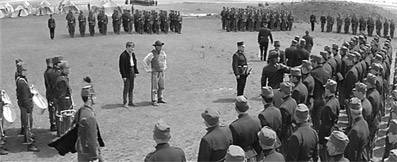
Given his critical standing and longevity, it seems odd to think that, to many, Jancsó remains just a name. The fact I, and many others had never seen any of Jancsó's extraordinary body of work before the post-millennial years, isn't due to lack of trying, but instead, lack of availability. The DVD and Blu-ray age means these previously narrow channels of access to foreign-language cinema have now been pushed wide open, allowing Jancsó's work to reach a bigger audience, be reappraised, and receive the attention it so richly deserves, both inside and outside his native Hungary. This merited attention, born from the discussion created by viewers seeing his work for the first time, also meant that Jancsó, like many before him, has entered a kind of second life, with the director well into his eighties when Second Run released Csillagosok, katonák/The Red and the White for the first time.
And what of that viewing experience? Jancsó's cinema is unique, one with its own language that's raw – in the pure, fresh sense, as opposed to the rough and ready – and elemental, in which everything is necessary, nothing superfluous. Jancsó's cinema isn't flashy or extravagant, but it is beautiful, to breathtaking degrees, even when at it's most brutal, shedding light on the darkest reaches of the world. The extravagance comes in its complexity and technical deftness rather than the smoke and mirrors of glamour. There's something primal and plaintive about his films, exploring events which are plucked, much like the man himself, from the obscurity of a history book. His place in that book is thoroughly deserved.
Jancsó is influential, oft-imitated, but rarely bettered, since no one can quite reach the heights of his technically masterful and pure cinema. From the moment you play the first disc, you'll see why he's held in such high regard. Some things, it seems, really are worth the wait.
Released in honour of Jancsó's 90th birthday, this specially priced three-disc set demonstrates how Second Run has established itself as a distributor of such consistent quality. All three discs arrive with restored picture and sound, as well as improvements to translation on the optional subtitles. The films themselves are the stars of the show. Made in an age when cinephiles didn't have the luxury of home entertainment, and seeing them at all was something of an expedition, then merely having them, and the ability to share that viewing experience will be enough. However, if you're hankering after some juicy cherries to put on top of an already decadent cake, then there's much more to savour. The supplements here genuinely complement the main features – particularly the interview with Jancsó on the extras for The Round-up – but they also give them context, deepening our understanding of what Jancsó's cinema is, what it does, what it means, and most importantly, what it has achieved for film culture.
Így jöttem/My Way Home (1964) |
|
My Way Home is based on a novel by Imre Vadász, while its screenplay was written by Jancsó's long-time collaborator, Gyula Hernádi. Set in Hungary during the final days of the Second World War, it tells the story of two 17-year-old boys, Hungarian Jóska (Jancsó regular András Kozák), and Russian soldier Kolya (Sergei Nikonyenko), his captor. Jóska makes his way across the Hungarian plains with a ragtag band of fellow travellers, as The Red Army advances, and the Germans retreat.
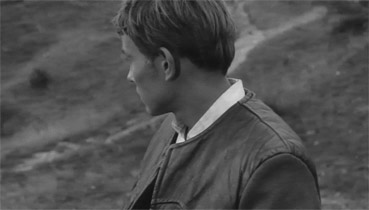
Constantly on guard, the group scatters when a biplane flies overhead, fearful they'll be shot. Separated from the others, and lacking in their experience, Jóska is captured twice in quick succession, latterly by Cossacks. They take him, the lone survivor of their shooting spree, to an isolated labour camp, where he's checked over for good health before being set to work. In a rare stroke of luck, he's released from the camp, and told to make his way home. Sadly, neither his freedom, nor his luck, last, and before he can make any real progress on that journey, he's captured for a third time, by Kolya, a boyish soldier who carries an injury from earlier in the war. Placed under his charge, the two work together to complete the milk run for the unit. Over time, they form an unlikely bond, and support each other to an almost brotherly degree.
My Way Home shows Jancsó in transition, leaving behind the Antonioni-like echoes of its predecessor, Cantata (if wanting for comparisons, this film has touches, as all Jancsó's films do to some degree, of Bresson), heading toward something entirely unique and unquestionably Jancsó, laying out the blueprint for a style which would become his trademark in the following years, reaching its height just under a decade later, in Még kér a nép/Red Psalm. These hallmarks are clear from the opening sequence, and glimpsed again throughout the film.
The beauty of My Way Home is in its purity, its startling clarity, and, sometimes, its brutality. From my description, this may sound like a rather saccharine against-the-odds buddy movie, but I can assure you, it's much more than that. This film is honest, closely observed, yet dream-like, because there's so much we don't know. So much is loaded within the beats of silence, as in Němec's Démanty noci/Diamonds of the Night, with which My Way Home shares both thematic and stylistic similarities. The budding friendship between Jóska and Kolya is the focus of the film, but the way we see that unfold, is pure Jancsó. Their bond is both tense, and intense. Tense in that Jóska is all too aware of the consequences for them both should he attempt an escape, so he stays, out of a curious sort of loyalty, to prevent Kolya from being reprimanded or worse. Intense, because the boys become close, ambling around the countryside; wading through the river, and taking pot shots at frogs with Kolya's gun, replaying the childhood the war years so obviously, painfully, robbed them of.
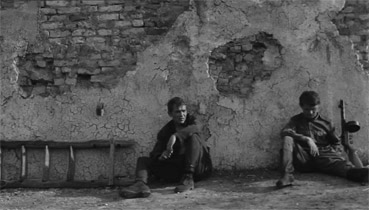
No frame of this film is wasted, nothing is superfluous, everything matters. A beautifully composed, and lyrical film, it also carries the mark of Jancsó's then favoured cinematographer, Tamás Somló (he would be replaced from Silence and Cry onwards by János Kende, a partnership which lasted for 25 years). Stylistically, My Way Home showcases the beginnings of a move toward freer camera work, a change from the fixed style seen in Cantata, and with it, the more elaborate setups Jancsó would require while working on location, and to create the long shots that would become integral to his aesthetic. Visually, this allows for the vastness of the Hungarian landscape, in almost panoramic glory, to come across. The boys are often dwarfed by their surroundings, and, in the wider shots, they look like tiny ants, scuttling across the land. More importantly, that sense of perspective flags up an important theme of the film beyond understanding and friendship: the idea of freedom as an illusion. Just as home for Jóska seems like a far off dream, so does freedom; fleeting and forever out of reach. There's simply too much ground for him to cover to effectively escape, and the vastness of it all seems never-ending. To attain it would be the equivalent of finding the horizon line to be as corporeal as a brick wall. This idea is reinforced by Jóska and Koyla surveying their world through binoculars, wary of distant figures, perhaps even wary of distance. At one point, Jóska upends them, to look through the lens instead of the eye piece, reversing their effect. It's a small yet significant moment in a film peppered with them.
One of the many reasons why My Way Home is such a powerful and affecting film is because it transcends boundaries of nation and barriers of language. Kolya knows no Hungarian, and Jóska's knowledge of Russian only extends to a few words, picked up from his fellow travelling companions. To us, though, it ceases to matter that Jóska is Hungarian (though repeatedly mistaken for German by the other people he meets) and Koyla is Russian, or that they are prisoner and guard. Once those labels drift away, what plays out is a universal story of human engagement that is, to all intents and purposes, carried out in silence, since the boys have no shared language. As viewers, we are placed in a position of privilege, since both the Russian and Hungarian dialogue is translated for us, but I'd argue that the film would resonate just as deeply if you turned them off. Ultimately, it doesn't really matter what they say to each other, but what they do for each other in spite of their differences, that matters. It's wonderful to watch them overcome the language barrier, and find things in common. That process of understanding is difficult, and carries with it the same engaging yet bittersweet quality of the romance in František Vláčil's Adelheid. An early misunderstanding sees Kolya shoot at Jóska, which he misinterprets as a threat to keep him from fleeing. Kolya is, in fact, trying to warn the other boy of the field of landmines he's about to step into, trying to protect him from harm using the only method at his disposal, and the only thing he knows Jóska can't ignore. It's a touching moment, and reflective of how close the boys will ultimately become.
Szegénylegények/The Round-up (1965)
|
|
Widely regarded as Jancsó's masterpiece, The Round-up was not only a domestic success, but also the first of the director's films to receive international recognition. The reasons as to why that is will reveal themselves within the opening moments of the film, and the rest of the runtime will stand as testament to the fact. Working again with Gyula Hernádi and Tamás Somló, Jancsó turns to an earlier period in Hungarian history. This time, it's the story of the few remaining Kossuth rebels, following the uprising of 1848. They are systematically hunted down and, as the title suggests, 'rounded up' like cattle (that they're herded around in groups just reinforces that idea), then detained in an isolated camp in an unnamed part of Hungary. Those men not killed outright are subjected to interrogation, constantly pressured by the officers at the camp to reveal the extent of their involvement in the rebellion and give away names of their compatriots.

A brutal, barren and bleak film, The Round-up is an exercise is discipline – literally, metaphorically and stylistically. Where My Way Home explored conflict and the aftermath of it from a personal, human perspective, The Round-up does everything to dehumanise and homogenise instead. Of course the faces of some men stand out, and become more familiar through the course of the film, their character is magnetic, and they draw you in, despite everything, particularly János (János Görbe), with his striking hat, fur coat and expressive face. Ultimately, even the film's most famous face, Zoltán Latinovits (who also appeared in Cantata and Silence and Cry), as militant Imre Veszelka, ultimately disappears into the mass of other prisoners, his story just one of many. You learn, quite quickly, not to become attached. The film is too rigid – as strict as the rules governing the lives of the men in the camp – to allow us to connect as we ordinarily would. The French language title for the film, 'Les Sans-espoir', translates as 'The Hopeless Ones,' and it's an apt label in more ways than one. These men are hopeless, desperate, with no one to speak for them, and everything stacked against them. That's exactly why it's so ruthlessly efficient in showing the ease with which power is abused, and just how high the cost of revolt can be. The violence shown throughout is senseless, ruthless, and, though bloodless, it's no less violent. In fact, it's equally as shocking as any Argento giallo yet to be born from Italian shores, and its coldness does nothing but add to its enduring allure.
Jancsó and Somló are both clearly growing in confidence, and that confidence helped Jancsó to define his own cinematic language and create a place where style and substance not only meet, but work together seamlessly.
While some films are black and white out of necessity, some films are born to be made in monochrome. The Round-up is one of them. It's hard to imagine what the film would be like if made in colour, but it's unlikely that it would be as powerful. The starkness of black and white takes the images we see to another level, and is very much a part of the film's atmosphere. The white prison buildings stand out in contrast to the darker, flat plains, recalling the drawings from the opening sequence, and page after page of letters home, printed on white pages, dissected by the pervading censorship. Closer shots focussing on bricks, lakes and woodlands bring texture and anchor the film, when it would be easy to let it float off into stylish yet hollow otherworldliness – sometimes the camp looks like it resides on a distant planet in a far off galaxy – while wide shots, which turn everyone into matchstick men, and render the prisoners insignificant, also stretch the capacity of Cinemascope both in terms of width and depth, giving us literal and figurative perspective in one go. This is, of course, where Jancsó's skill at choreographing large groups of people begins to shine through, and are used to particular effect. The large-scale scenes, containing prisoners and officers – both marching and on horseback – are dazzling in their complexity. Given The Round-up's stark qualities, it's something of a surprise to realise how fuelled, how full of energy and action it is.
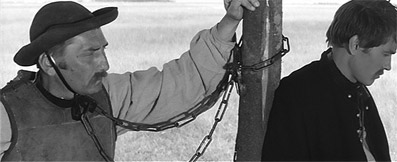
While some films are black and white out of necessity, some films are born to be made in monochrome. The Round-up is one of them. It's hard to imagine what the film would be like if made in colour, but it's unlikely that it would be as powerful. The starkness of black and white takes the images we see to another level, and is very much a part of the film's atmosphere. The white prison buildings stand out in contrast to the darker, flat plains, recalling the drawings from the opening sequence, and page after page of letters home, printed on white pages, dissected by the pervading censorship. Closer shots focussing on bricks, lakes and woodlands bring texture and anchor the film, when it would be easy to let it float off into stylish yet hollow otherworldliness – sometimes the camp looks like it resides on a distant planet in a far off galaxy – while wide shots, which turn everyone into matchstick men, and render the prisoners insignificant, also stretch the capacity of Cinemascope both in terms of width and depth, giving us literal and figurative perspective in one go. This is, of course, where Jancsó's skill at choreographing large groups of people, begins to shine through, and are used to particular effect. The large-scale scenes, containing prisoners and officers – both marching and on horseback – are dazzling in their complexity. Given The Round-up's stark qualities, it's something of a surprise to realise how fuelled, how full of energy and action it is.
The Round-up is a complex, incredibly taut piece of cinema. From the moment we hear the opening voiceover, ominous and full-throated, intoning like the voice of God – part sermon, part history lesson – and watch the slideshow of sketches featuring weapons, instruments of torture and building plans, we're on edge. That feeling of intense unease never dulls, from the first frame to the last. Viewers at the time of its release, with the shadow of the 1956 Hungarian Uprising still hovering, would have connected with, and be drawn towards the material. Frequently cited as an allegory for 1956 (even by Jancsó himself), The Round-up certainly gives voice to national concerns without directly addressing them, which would've been unthinkable at the time, due to the fact that cinema was state funded. That connection, and its topicality remains for contemporary audiences too. Far from looking dated, the film is fresh and prescient in a way that Jancsó could've never possibly imagined. Echoes of Egypt, Iran, Iraq, Afghanistan and Guantanamo Bay are all there should you choose to see them. History, as Marx said, is doomed to repeat itself. Often, the passage of time means the potency of an acclaimed work becomes diluted. In the case of this film though, the resonance of it, and the clarity of its message has grown sharper, clearer and evermore intense.
Csillagosok, katonák/The Red and the White (1967)
|
|
Though the newest of Jancsó's films presented in this set, it was the first of them to be released by Second Run, and signalled the DVD arrival of his work in the English-speaking world. Building upon the themes set up in The Round-up, The Red and the White, set in 1919, centres on the aftermath of the Soviet Revolution. The 'Red' of the title denotes the Soviet revolutionaries, while its 'White' refers to the Tsarists, who are striving to retain power at all costs. .If the tone of The Round-up, its companion film in many ways, can be considered cool, and represented a dark part of history, then The Red and the White chills to the bone, stills the blood quicker than Moscow in the depths of winter, and shows the heart of human darkness: the extent of our capacity to be inhumane.
The Red and the White is a collaborative piece, a Hungarian-Soviet co-production, with a screenplay written by Hernádi and along with Gyula Miklós, Luca Karall, Valeri Karen, and Giorgi Mdivani – all brought together to create a film to commemorate the 50th anniversary of the October Revolution. On paper, Jancsó seemed the perfect choice, given the positive representation of friendship in My Way Home, and his clear gift for elaborately staged, large-scale productions. What was expected from Jancsó and what The Red and the White ultimately became were two very different things. Upon seeing the final result, a boldly realised anti-war film, with cutting social critique to boot, the Soviet co-producers banned the film from distribution in the USSR. The answer as to why is simple, and will be abundantly clear from the moment the film begins proper. The Red and the White isn't a celebration, it's a commiseration.
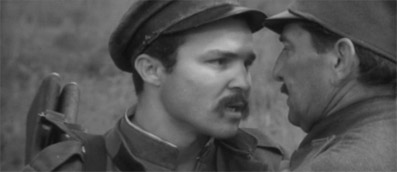
As with The Round-up, the grouping of people, and their degradation and humiliation is routine. Jancsó's trope of using nakedness to represent both is used to great effect, particularly when the twist of fate turns on the nurses caring for the wounded soldiers. That the women of Red Psalm reclaim that association, and turn it into an act of rebellion just makes their own plight all the more harrowing, purely because they don't have the wherewithal to stand up against those who oppress them. That's by no means a slight, these women are brave and strong, as strong as the men who subdue them, but it's more a reflection of the complete lack of kindness exhibited within the film. The one, painfully brief exception is the romance between a nurse and a soldier. It stands out as a brief, weak ray of sun in an otherwise harsh landscape.
There are other battles to be fought of course, not just ones involving weapons and the long, unkempt grass of a battlefield: the battle to survive. Death, and the threat of it hangs in the air, sweeps in, unannounced, claims its victim and then retreats – the men even play dead, camouflaging themselves amongst the bodies of the fallen to avoid detection when attempting to escape. And so, the cycle continues, one that's made all the more powerful because there's rarely a fight; there's no pleading, no screaming, not even so much as a whimper. Instead, there's only a horrible sense of dread and inevitability. Perhaps the most haunting thing of all is the sound often heard after the firing of a bullet: sweet, trilling birdsong. It stands, like that isolated romance, as a tragic little beacon; the fleeting sound of hope.
What makes The Red and White so fascinating is that we know so little in the factual sense about what's presented to us. Names and places are superfluous here, and that certainly makes for a confusing experience, until you realise that's how the film is meant to be. That lack of knowledge doesn't lessen it's power, but rather, intensifies it. By not tying things down to specifics, the story transcends its basis to become deeper and more profound. It would be easy to suggest that Jancsó is in the habit of populating his cinematic worlds with archetypes to allow for greater resonance, but that seems a rather superficial way of looking at things. Yes, the armies presented here stand for thousands, even millions of souls, but that just reinforces the fact that conflict, that oppression and the desire to rise up against it is a never-ending, vicious cycle. However, amongst this wider social commentary, The Red and White also makes time to consider the role of one man, a cog in the vast war machine, and his moral choices he undertakes. It's no coincidence that one man who features heavily throughout the film will be familiar to Jancsó aficionados. András Kozák, star of My Way Home, appears as Lazlo, a young Red. In a particularly poignant, if loaded scene – the casting seems too purposeful and neat to be arbitrary, as if Lazlo is a relative of Jóska's in some other reality – he stumbles bewildered through the battlefield, in a uniform slightly too big for his small frame, brandishing a sword, but with no real idea of it's power or perhaps too much of an idea.
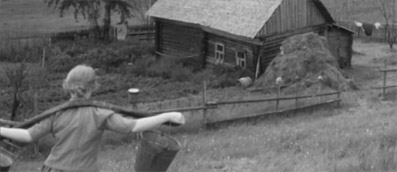
A difficult and decidedly oblique film, The Red and the White is also methodical and calculated, employing distancing techniques to take us away from the action – it feels as if we're actually watching things through a lens, a step or so removed. However, Jancsó's work is such that you can't help but be drawn into its insular nature. It wraps around you, tests all your senses, you can sink into it, breathe it in and immerse yourself inside of it. The Red and the White, more than any Jancsó film is a concrete world. Complete. Faults and all.
Viewed alongside its predecessors, the picture of war created by The Red and the White is devastating. It fills in the detail that The Round-up and My Way Home only briefly sketched out. Everything, from the ground up, is bigger and bolder, as if Jancsó placed all the elements of his unique filmmaking style under a microscope and replicated the intensification. There's no heroics, no glamour, and no glory in the war presented here, only the harsh sting of truth, and the bitter taste left behind by the realisation that the fight engaged in is often a futile one. As a result, it's not the easiest of films to watch, and is perhaps the most divisive of his films, but then, those were undoubtedly Jancsó's intentions.
My Way Home is presented at close to 1.78:1 (technically it fills the 16:9 screen, but there is a small black bar to the right of the picture) and is anamorphically enhanced. The restored print is in impressive shape, boasting strong black levels, a pleasing grey scale, and impressive detail for a DVD picture (how Blu-ray has spoilt us in this respect). A few dusts spots are still present, but they are rare enough not to notice them unless you are specifically looking. The mono 2.0 soundtrack displays the expected range restrictions and treble clipping on dialogue, but is otherwise solid, with no distracting damage or background hiss.
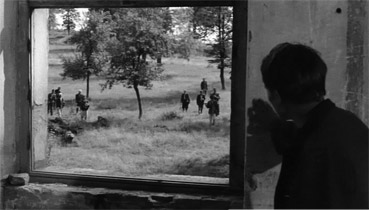
The Round-Up is in its original 2.35:1 anamorphic ratio and is anamorphically enhanced. The tonal range here is certainly on a par with May Way Home, retaining solid blacks without sacrificing grey scale detail, though there are some minor highlight burn-outs on sunlit exteriors. The transfer suffers slightly from shimmering on some of the edges, suggesting that the print has undergone either some form of digital enhancement or has been sourced from high-band tape. The picture has been cleaned up and the detail in night scenes has been retained without washing the black levels out, which always impresses. The mono 2.0 sound does slightly better by the dialogue than the one on My Way Home, but has a few minor pops of damage and a very background audible hum that runs throughout.
The Red and the White is the most recent of the films here was the first to be released on DVD (it was first released back in 2006) and has the weakest transfer. 2.35:1 and anamorphically enhanced, the tonal range is rather good, but the image itself is softer than its predecessors, and even the norm for a DVD picture. Some dust and scratches are visible but not really intrusive, and for the most part the picture is stable and consistent in its brightness and contrast. There is some blurring of motion on some shots, and very occasionally what looks like scan lines are visible, suggesting a high-band tape source. This is one of those times, however, when the greatness and the relative rarity of the film should prompt you to ignore such imperfections. There is some variance to the clarity of the Dolby mono 2.0 soundtrack, being sometimes crisp and distinct (the gunfire of the aerial attack 47 minutes in is particularly good), while at others slightly muffled, suggesting a restoration assembled from more than one original.
MY WAY HOME
Message of Stones: Máramaros (50:40)
The second award-winning film in Jancsó's renowned, but rarely seen 1994 documentary series, A kövek üzenete /Message of Stones (other films from the series can be found as part of the supplemental material for Még kér a nép/Red Psalm, and The Red and the White, and, in the latter case, is discussed below), focuses this time on the inhabitants of the Máramaros County region, whose territories are now split between north-western Russia and the Ukraine.
This is a beautifully composed glimpse into ordinary lives and the kind of communities we're a part of, whether that's a family around a dinner table, a group of friends together or a synagogue congregation at prayer. There's great warmth and affection on display, as well as real sense of pride for their heritage, whether Jewish or Hungarian, and yet, there's something incredibly haunting, almost sorrowful about the wise faces Jancsó and his team encounter; all trying to cling on to the traditions they hold so dear.
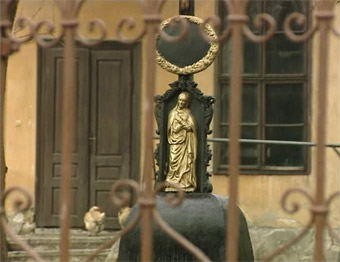
Rain-soaked, atmospheric, and so deeply rooted within Máramaros that you can almost smell the grass and earth, the film is held together with music from Gheorge Govaci, and folk songs that are both the life blood of these people and part of the connective threads that keep them together.
In many ways, this film is the most representative of the ideology behind the Message series as a whole. Through the medium of film, Jancsó explores his fascination and connection with Jewish culture in a way that allows its traditions not only to be observed, but also, pivotally, to be preserved and valued. Like its predecessor, Hegyalja, this too, feels like a postcard-turned-love letter to the country and its people.
This 16-page fully illustrated booklet is dedicated to a beautifully written, articulate, and impassioned piece by Penelope Huston, which first appeared in Sight and Sound in 1969, shortly after Jancsó's films were filtering through to Western audiences. In addition to discussion of My Way Home, it also gives attention to The Round-Up, The Red and the White and Jancsó's international breakthrough film, Csend és kiáltás /Silence and Cry. If you're encountering Jancsó's films for the very first time, be warned, the article reveals plot points for all the films discussed above. However, if you're thirsty for knowledge, you'll be hard-pressed to find a better starting point than this. Huston's writing remains fresh and engaging, and is an invaluable window upon contemporary film criticism and the emergent discourse surrounding Jancsó's work beyond his native Hungary. Fascinating.
The Round-up
Interview with Miklós Jancsó (19:03)
Filmed and edited by Jancsó's sons, Nyika and David (both successful in their own right as a cinematographer and editor respectively), this relatively brief discussion – Jancsó is the kind of person you could hear talk for days and not become bored – is wonderful to watch, not least because we actually see Jancsó, 86-years-old at the time, on camera. This is interesting in itself of course, there's always something intriguing about seeing a director of Jancsó's stature in front of the camera rather than behind it, and that's even before we get to hear what he has to say.

As you might expect, given his experiences and the longevity of his career, he has plenty to discuss, covering everything from his background to the challenges of working as a director in Hungary throughout turbulent times, and, most fascinating of all, his own interpretations of his work, with specific reference to The Round-up. This is one of the most enjoyable and valuable pieces of supplemental material I've seen in a long time, especially in terms of this release and the film's status within Jancsó's body of work.
Booklet
A 16-page illustrated booklet featuring an essay by John Cunningham, Senior Lecturer in Film Studies at Sheffield Hallam University, and author of the seminal book, Hungarian Cinema: From Coffee House to Multiplex (which this piece borrows from).Well-known for his love of, and writings upon, Eastern European cinema, that passion certainly comes through here. Written with authority, and a great deal of affection, this piece is a great compliment complement to the Huston one. The passage of time means that Cunningham has more information at hand and can approach Jancsó's work with a broader sense of the director's critical standing within film discourse, as well as providing important historical and political context on Hungary itself. Weaving together biographical information with close reading of The Round-Up, this is a great read, and broadens our understanding of Jancsó and the film itself. As with the Huston essay, the specific discussion on The Round-Up reveals elements of the plot, so should be read after a first viewing, in order to avoid being spoiled.
The Red and the White
Message of Stones: Budapest (53:37)
The first film in the A kövek üzenete /Message of Stones documentary series, which is dedicated to Budapest. Setting up the impressionist mode of the films that would follow it, the film opens with somewhat mournful flute music, played by famed musician Ádám Török, and slow-motion shots. From then on, we 'tour' around Budapest, taking in synagogues, schools, and other places along the way, with Török providing the soundtrack to the journey. He experiences things with us, playing along like a wandering minstrel, mimicking the 'wandering' eye of the camera; and then the series' second trait: exploration and representation of Jewish culture, comes into play.
It's as absorbing and equally powerful as the other Message of Stones films. In being the first film of the series, it poses questions not only about his documentarist impulses, but also about the degree to which the aesthetic he employs in his narrative cinema is reflected in his documentary work. Those well-versed in his output will certainly see just how Jancsóesque these films are, especially if they're watched in sequence, after the features presented in this box set.
In terms of tone, this is probably the lightest of the series. In contrast to the Máramaros film, Budapest is more concerned with celebration and self-expression through creativity, be that singing, dancing, making music or performing a play. Taken as a whole, the Message of Stones series has, until now at least, been critically overlooked, but it is an incredibly valuable social, cultural, and historical document, which also offers us insight into the many facets of Jancsó's filmmaking.
Booklet
This 20-page illustrated booklet is given over entirely to an interview with Miklós Jancsó conducted by critic/writer Andrew James Horton, and originally appeared on his renowned journal dedicated to Central and Eastern European cinema, Kinoeye (sadly no longer published, it now only exists in partial archive form) in 2003. As someone who enjoys reading interview material, particularly when dedicated to a figure as revered as Jancsó, this was a real pleasure to read, purely because it fleshes out the director as a human being, revealing the artist behind the art, something which can be lost when stepping back to consider the oeuvre of a man who has been involved in film culture for so many years. Jancsó is on fine form here, full of energy and excitement for the new wave of success his films have received in his latter years, due, in no small part, to companies like Second Run.
For those yet to see the work of Miklós Jancsó, one of Hungarian cinema's most revered and influential practitioners, this set is a perfect introduction. For those already enamoured with his potent and poetic brand of cinema, this collection is a beautifully presented celebration of it. An essential purchase.
|